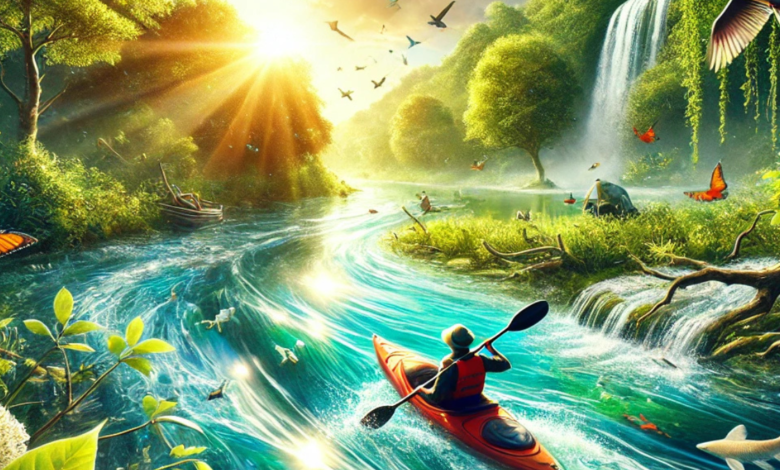Beauty and Mystique of a River Run

Introduction: What Is a River Run?
A river run is not just a geographical term; it’s an experience, a connection to the flowing lifeblood of nature. At its core, a river run refers to the natural or artificial course through which a river flows, often characterized by dynamic landscapes, vibrant ecosystems, and the soothing sound of water cutting through terrain. But it’s more than just a physical journey; it’s a metaphor for life, with its ups and downs, twists and turns, and the constant movement forward.
Whether you’re an adventurer navigating rapids, a nature lover admiring serene waters, or simply someone who finds peace in the rhythm of flowing streams, the river run holds something magical. In this article, we’ll explore its diverse aspects, from its ecological significance to its recreational allure, and why it remains a timeless inspiration.
The Ecology of River Runs: A Vital Lifeline
Rivers are among the most vital ecosystems on Earth. A river run serves as a lifeline, supporting an incredible array of flora and fauna. From towering trees that line its banks to the microscopic organisms that thrive in its waters, every component plays a role in maintaining ecological balance.
- Biodiversity at Its Best A healthy river run is teeming with life. Fish dart through its waters, amphibians make their homes on its edges, and birds soar above, relying on its bounty for survival. This biodiversity isn’t just beautiful—it’s essential. Rivers act as corridors for wildlife, providing pathways for migration and breeding grounds for many species.
- Nutrient Transport and Soil Enrichment As rivers flow, they carry sediments and nutrients that enrich the soil in surrounding areas. These deposits make river valleys some of the most fertile regions on Earth, supporting agriculture and vegetation. Without the natural flow of a river run, these ecosystems would struggle to thrive.
- Natural Water Filtration Rivers play a crucial role in filtering water. Wetlands associated with river systems act like natural sponges, absorbing pollutants and purifying the water before it reaches larger bodies like lakes and oceans. This self-cleaning mechanism is vital for maintaining the health of aquatic ecosystems and ensuring clean water for human use.
Recreational Joys: A River Run for Everyone
For many, a river run is synonymous with adventure and relaxation. It’s where adrenaline meets tranquility, offering activities for thrill-seekers and peace-lovers alike.
- Kayaking and Canoeing Adventures Few things compare to the thrill of paddling down a river run. Whether you’re navigating gentle currents or braving white-water rapids, kayaking and canoeing offer a unique way to experience the power of a river. These activities not only test your physical endurance but also immerse you in the raw beauty of nature.
- Fishing: A Timeless Pastime For those who prefer a more relaxed approach, fishing along a river run is a cherished activity. Rivers are home to a variety of fish species, from trout in cool mountain streams to catfish in warmer waters. Anglers often find solace in the quietude of a river, making it as much about the experience as the catch.
- Hiking Along the Banks Hiking trails that follow river runs provide an excellent way to explore the surrounding landscapes. From shaded forests to sunlit meadows, these trails offer scenic views and a chance to connect with nature on foot. Many of these paths lead to hidden gems like waterfalls, rock formations, and breathtaking vistas.
The Cultural and Historical Significance of River Runs
Rivers have always been central to human history and culture. Civilizations have risen and fallen along riverbanks, and their influence can be seen in everything from literature to art.
- Cradles of Civilization Major civilizations, such as those along the Nile, Tigris, Euphrates, and Indus rivers, owe their existence to river runs. These waterways provided fresh water, food, and transportation, making them hubs of early human activity. Even today, many cities are built around rivers, highlighting their continued importance.
- Inspiration for Art and Literature Rivers have long inspired creativity. Poets, painters, and musicians have all found beauty and meaning in the ebb and flow of a river run. From Mark Twain’s The Adventures of Huckleberry Finn to Claude Monet’s serene river scenes, these waterways are a recurring motif in human expression.
- Rivers in Mythology and Spirituality Rivers often hold spiritual significance in various cultures. The Ganges in India is considered sacred, while the Styx in Greek mythology represents the boundary between life and death. These stories reflect the deep connection humans have with rivers as symbols of life, renewal, and transition.
The Challenges Facing River Runs
Despite their importance, river runs face numerous threats in the modern world. Climate change, pollution, and overuse have taken a toll on these vital ecosystems.
- Climate Change and Its Impact Global warming has disrupted the natural flow of many rivers. Glaciers that feed river systems are melting at unprecedented rates, altering water levels and temperatures. This not only affects wildlife but also communities that rely on rivers for drinking water and irrigation.
- Pollution and Industrialization Industrial waste, agricultural runoff, and plastic pollution are choking river runs around the world. These pollutants harm aquatic life and reduce the quality of water, making it unsafe for human and animal consumption. Efforts to clean up rivers are ongoing, but the scale of the problem remains daunting.
- Dams and Altered Flows While dams provide hydroelectric power and water storage, they also disrupt the natural flow of rivers. This can harm fish populations, reduce sediment transport, and change the overall health of the river ecosystem. Balancing human needs with ecological sustainability is a critical challenge.
Why We Must Protect Our River Runs
The protection and preservation of river runs are essential for our planet’s future. Without healthy rivers, ecosystems collapse, communities suffer, and natural beauty fades away.
- Restoration Projects Many organizations and communities are working to restore degraded river runs. From removing dams to planting vegetation along riverbanks, these efforts aim to bring rivers back to their natural state. Such projects not only benefit wildlife but also improve water quality and enhance recreational opportunities.
- Community Involvement Protecting river runs requires collective action. Local communities play a crucial role in keeping rivers clean and healthy. Initiatives like clean-up drives, educational programs, and advocacy can make a significant difference in preserving these waterways.
- Sustainable Practices Adopting sustainable practices in agriculture, industry, and daily life can reduce the strain on river systems. By using water responsibly, reducing pollution, and supporting renewable energy sources, we can ensure that river runs continue to thrive for generations to come.
Conclusion: The Eternal Flow of Life
A river run is more than just a flowing body of water—it’s a reminder of life’s journey. From its ecological significance to its cultural impact and recreational appeal, it holds a unique place in our hearts and minds. However, the challenges facing river runs require our immediate attention and action.
By appreciating their beauty, understanding their importance, and working to protect them, we can ensure that river runs remain a source of inspiration, sustenance, and joy for future generations. So, the next time you find yourself near a river, take a moment to listen to its song and marvel at its endless flow—it’s a connection to the very essence of life.





